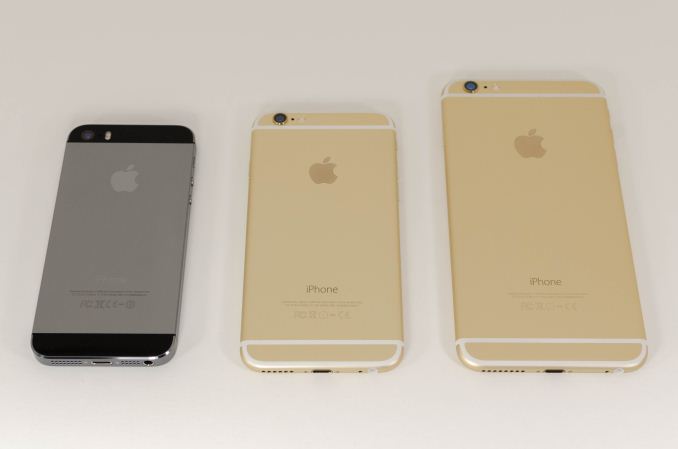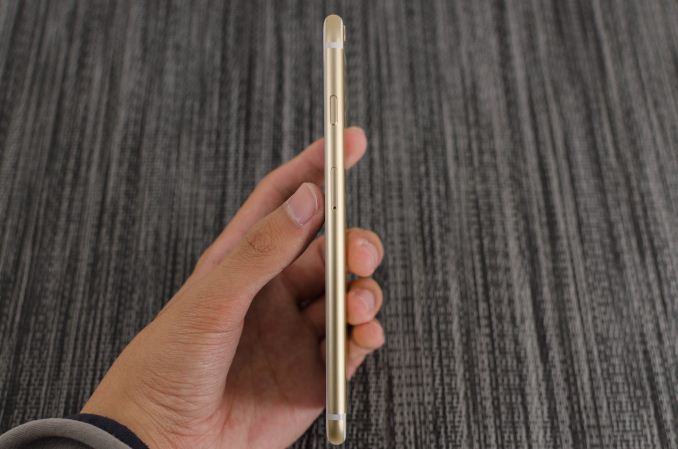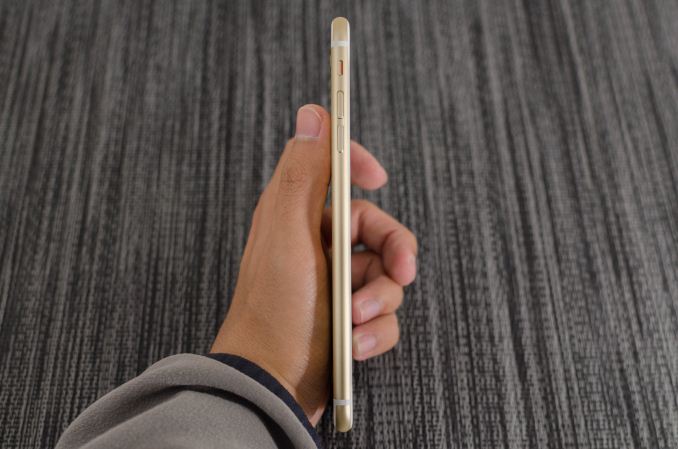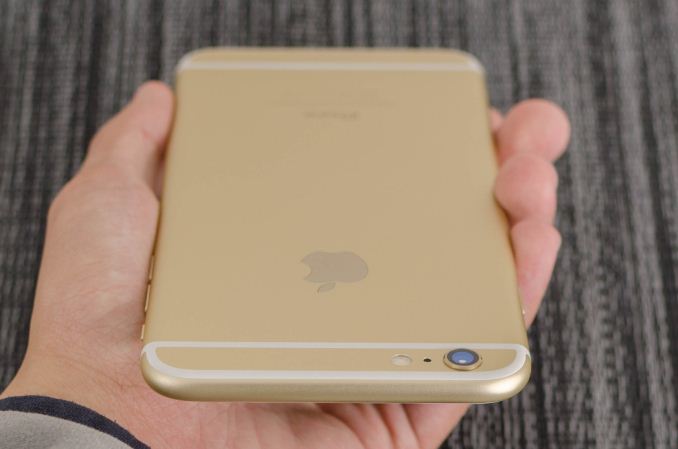The iPhone 6 Plus Mini-Review: Apple's First Phablet
by Joshua Ho on September 30, 2014 8:00 AM EST- Posted in
- Smartphones
- Apple
- Mobile
- iOS
- iPhone 6 Plus

While we’ve also written about the iPhone 6, the iPhone 6 Plus needs its own review in order to really understand the various features of the device that would otherwise be buried in the context of the iPhone 6. Without question, this device represents a significant departure from the way Apple has competed in the smartphone space. Until now, Apple hasn't competed in the phablet space and has thus avoided competing with Galaxy Note line that has been established as the dominant phablet for the past 3-4 generations. As a result, Apple occupies a fast-follower position at best.
This brings us to the iPhone 6 Plus, which really is an extension of the iPhone 6. Both phones share the same SoC, NAND configurations, front and rear camera sensors, LED flash module, industrial/material design, TouchID home button, earpiece and speaker configuration, WiFi/BT chipset, modem, and button layout. At this point, I’m going to stop listing similarities because the iPhone 6 Plus is interesting for its differences. Unlike similarities, the differences are simple. The iPhone 6 Plus is bigger, the display has higher pixel density, the camera has optical image stabilization, and iOS 8 has new app designs to take advantage of the larger screen. The iPhone 6 Plus is also more expensive, with the 16GB version starting at the same price as the 64GB version of the iPhone 6.
While I’ve already discussed the design of the iPhone 6, it’s important to see whether the same design translates to the iPhone 6 Plus. To this end, the iPhone 6 Plus does well. While the angular design of the iPhone 5 line would have looked and felt enormous in the hand, the shape is quite similar to the iPad line and is similarly comfortable in the hand, although the rounded edge really differentiates it, as does the control scheme. The only real issue here is that the top bezel on the front becomes surprisingly large, and this seems to contribute to a sense that the phone is top-heavy even though the phone is evenly balanced.
| Apple iPhone 5s | Apple iPhone 6 | Apple iPhone 6 Plus | |
| SoC | Apple A7 | Apple A8 | Apple A8 |
| Display | 4-inch 1136 x 640 LCD | 4.7-inch 1334 x 750 LCD | 5.5-inch 1920 x 1080 LCD |
| WiFi | 2.4/5GHz 802.11a/b/g/n, BT 4.0 | 2.4/5GHz 802.11a/b/g/n/ac, single stream, BT 4.0, NFC | |
| Storage | 16GB/32GB/64GB | 16GB/64GB/128GB | 16GB/64GB/128GB |
| I/O | Lightning connector, 3.5mm headset | ||
| Size / Mass |
123.8 x 58.6 x 7.6 mm, 112 grams |
138.1 x 67 x 6.9 mm, 129 grams |
158.1 x 77.8 x 7.1 mm, 172 grams |
| Camera |
8MP iSight with 1.5µm pixels Rear Facing + True Tone Flash 1.2MP f/2.4 Front Facing |
8MP iSight with 1.5µm pixels Rear Facing + True Tone Flash 1.2MP f/2.2 Front Facing |
8MP iSight with 1.5µm pixels Rear Facing + True Tone Flash + OIS 1.2MP f/2.2 Front Facing |
| Price |
$99 (16GB), $149 (32GB) on 2 year contract |
$199 (16GB), $299 (64GB), $399 (128GB) on 2 year contract |
$299 (16GB), $399 (64GB), $499 (128GB) on 2 year contract |
Overall, even though the iPhone 6 Plus is noticeably taller than the Galaxy Note 3 both feel similar in size. The iPhone 6 Plus is on the thinner side which makes a significant impression in the hand. At any rate, it’s physically impossible for me to use this device with one hand for most situations. It’s definitely a tablet in this sense, but in a much more compact and pocketable form factor.
"Bendgate"
Of course, drawing the comparison between the iPhone 6 Plus and Galaxy Note 3 inevitably raises the question of “bendgate”, which draws interesting parallels with “scuffgate” from the iPhone 5 generation. Unfortunately, I can’t destroy multiple review units in order to thoroughly investigate this issue. However, we can look at Consumer Reports’ data and come to a few conclusions about this problem. The first is that in the case of the iPhone 6 Plus, there appears to be an area near the bottom of the volume buttons that is a weak point as we see a clear failure of the casing in this area.
However, it seems that there is a significant amount of force needed in the first place in order to cause permanent deformation. Otherwise, everything that we’ve seen is primarily the result of fundamental differences between the two materials. It’s clear that in the case of the Galaxy Note 3 that a great deal of the structural rigidity is tied to the display itself, so the case doesn’t quite provide much in the way of protection as the polymer used is clearly in the elastic region all the way to failure. LG seems to have a different design though, as their polymer material has a clear case of brittle failure at the limit, which saved the display from shattering.
It's certainly possible to bend the iPhone 6 Plus (or really any phone or tablet), but the real issue here that hasn’t been addressed is the level of force needed to cause a certain level of elastic or plastic deformation in the material. This matters far more when discussing drop protection as the level of force in such a scenario is relatively small but applied over an extremely short period of time. There’s also no mention of force per unit area in any of these figures, so we can’t really have a serious discussion about this issue without the necessary data.














191 Comments
View All Comments
Alexey291 - Tuesday, September 30, 2014 - link
well CR has stated that IP6+ bends under what? 60lb's of force applied at dead center of the phone. Which compares to roughly 100+ (130 seems to be the usual number) lbs of force required to bend or damage other devices.I agree CR isn't in apple's pocket. They just gently on apple's parade. Gentle like
trololololol - Tuesday, September 30, 2014 - link
The HTC One M8 fared the worst.Laxaa - Wednesday, October 1, 2014 - link
The problem is that there seems to be a structural weakness near the volume buttons. That's what people are reporting and that's what CR should have tested.douglaswilliams - Tuesday, September 30, 2014 - link
Two quotes:"It's also important to note that the iPhone 6 Plus is rendering at 2208x1242 internally in order to keep proper scaling with the 163 points per inch system that iOS has, which accounts for part of the performance delta."
and
"The use of the 2208x1242 resolution with downscaling..."
Why would the iPhone 6 Plus render at such a high resolution?
How much of performance hit is taken due to this extra unused rendering?
There is also not much info on graphics performance in general. With the 6+ having 2.07x as many pixels as the 6, but the same GPU, I would expect it to take a huge graphics performance hit.
Can you comment on this? Perhaps there is some data in the iPhone 6 review - I haven't read that yet.
Thank you.
uhuznaa - Tuesday, September 30, 2014 - link
The downscaling happens in specialized hardware right on the SoC (much like video decoding), shouldn't have much (if any) impact on performance.solipsism - Tuesday, September 30, 2014 - link
Has he mentions, to keep proper scaling. The Retina devices scaled at 2x, this scales at 3x. 2208x1242 is a perfect 3x scaling, but that physical display (probably for multiple reasons) wasn't viable at this time for the device.Applebot - Tuesday, September 30, 2014 - link
A dumbed-down lazy review. I expect better from Anandtech.solipsism - Tuesday, September 30, 2014 - link
What exactly is dumbed down about it? Did you not see that the full review of the iPhone 6 series is in another article?Alexey291 - Tuesday, September 30, 2014 - link
Well just about everything really :)That's kinda the point. Its a review that you can usually find on engadget. With a conclusion to match. (I am talking about the wording not the content of the conclusion)
hlovatt - Wednesday, October 1, 2014 - link
That is unfair comment; the combined 6 & 6+ reviews are the most detailed I have seen on the web, do you have 2 or 3 more detailed reviews to support your assertion?If not you should apologise for denigrating the hard work AnandTech put into all their testing.
If AnandTech isn't supported there will be no in-depth reviews at all.